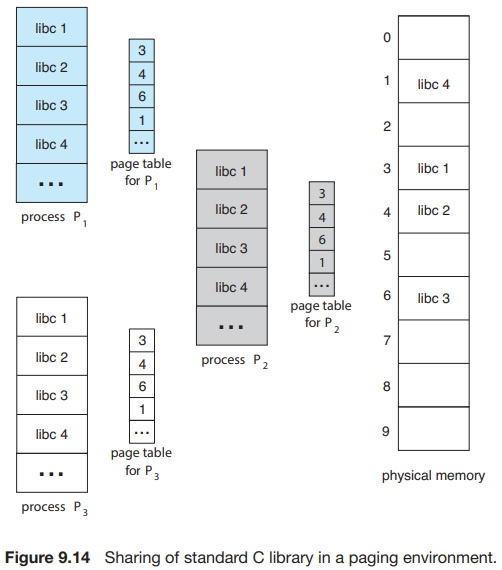An advantage of paging is the possibility of sharing common code, a consideration that is particularly important in an environment with multiple processes. Consider the standard C library, which provides a portion of the system call interface for many versions of UNIX and Linux. On a typical Linux system, most user processes require the standard C library libc. One option is to have each process load its own copy of libc into its address space. If a system has 40 user processes, and the libc library is 2 MB, this would require 80 MB of memory.

If the code is reentrant code, however, it can be shared, as shown in Figure 9.14. Here, we see three processes sharing the pages for the standard C library libc. (Although the figure shows the libc library occupying four pages, in reality, it would occupy more.) Reentrant code is non-self-modifying code: it never changes during execution. Thus, two or more processes can execute the same code at the same time. Each process has its own copy of registers and data storage to hold the data for the process’s execution. The data for two different processes will, of course, be different. Only one copy of the standard C library need be kept in physical memory, and the page table for each user process maps onto the same physical copy of libc. Thus, to support 40 processes, we need only one copy of the library, and the total space now required is 2 MB instead of 80 MB-a significant saving!
In addition to run-time libraries such as libc, other heavily used programs can also be shared-compilers, window systems, database systems, and so on. The shared libraries are typically implemented with shared pages. To be sharable, the code must be reentrant. The read-only nature of shared code should not be left to the correctness of the code; the operating system should enforce this property.
The sharing of memory among processes on a system is similar to the sharing of the address space of a task by threads. Furthermore shared memory as a method of interprocess communication. Some operating systems implement shared memory using shared pages. Organizing memory according to pages provides numerous benefits in addition to allowing several processes to share the same physical pages.
About the Authors
Abraham Silberschatz is the Sidney J. Weinberg Professor of Computer Science at Yale University. Prior to joining Yale, he was the Vice President of the Information Sciences Research Center at Bell Laboratories. Prior to that, he held a chaired professorship in the Department of Computer Sciences at the University of Texas at Austin.
Professor Silberschatz is a Fellow of the Association of Computing Machinery (ACM), a Fellow of Institute of Electrical and Electronic Engineers (IEEE), a Fellow of the American Association for the Advancement of Science (AAAS), and a member of the Connecticut Academy of Science and Engineering.
Greg Gagne is chair of the Computer Science department at Westminster College in Salt Lake City where he has been teaching since 1990. In addition to teaching operating systems, he also teaches computer networks, parallel programming, and software engineering.
The tenth edition of Operating System Concepts has been revised to keep it fresh and up-to-date with contemporary examples of how operating systems function, as well as enhanced interactive elements to improve learning and the student's experience with the material. It combines instruction on concepts with real-world applications so that students can understand the practical usage of the content. End-of-chapter problems, exercises, review questions, and programming exercises help to further reinforce important concepts. New interactive self-assessment problems are provided throughout the text to help students monitor their level of understanding and progress. A Linux virtual machine (including C and Java source code and development tools) allows students to complete programming exercises that help them engage further with the material.
A reader in the U.S. says, "This is what computer-related books should be like. It is thorough, in depth, information packed, authoritative, and exhaustive. You cannot get this kind of excellent information from the Internet - or many other computer books these days. It's a shame that quality computer books are declining so rapidly in number. I hope they continue to update and publish this book for many years to come.
More Computer Architecture Articles:
• The Motherboard Chipset
• AMD Sempron Processor
• Round-Robin CPU Scheduling Algorithm
• Operating System Services
• Operating System Memory Allocation Methods
• Capacitors in DC Circuits
• Direct Memory Access (DMA)
• The Android Operating System
• Priority CPU Scheduling Algorithm
• Interrupt Request Lines (IRQs)



